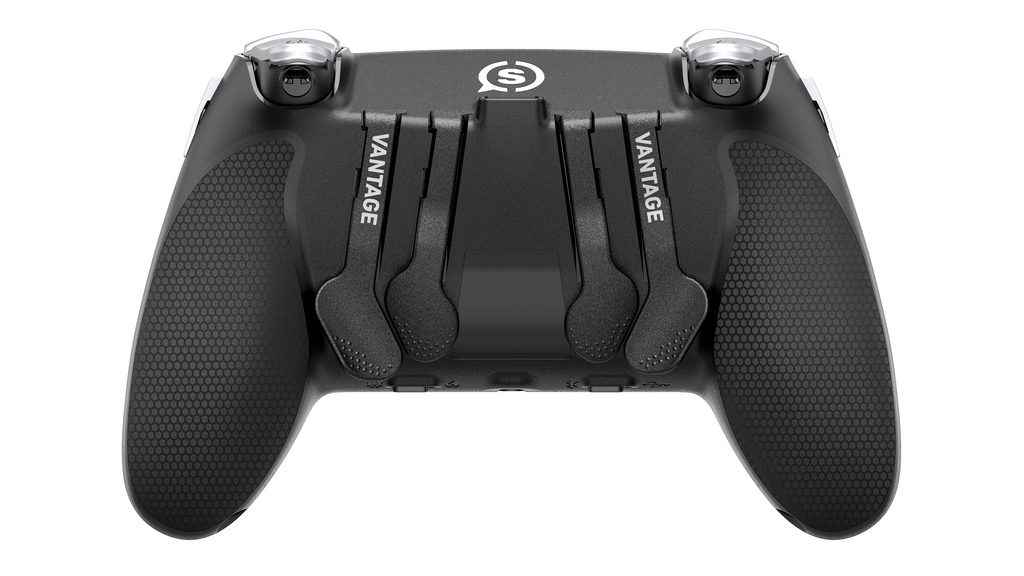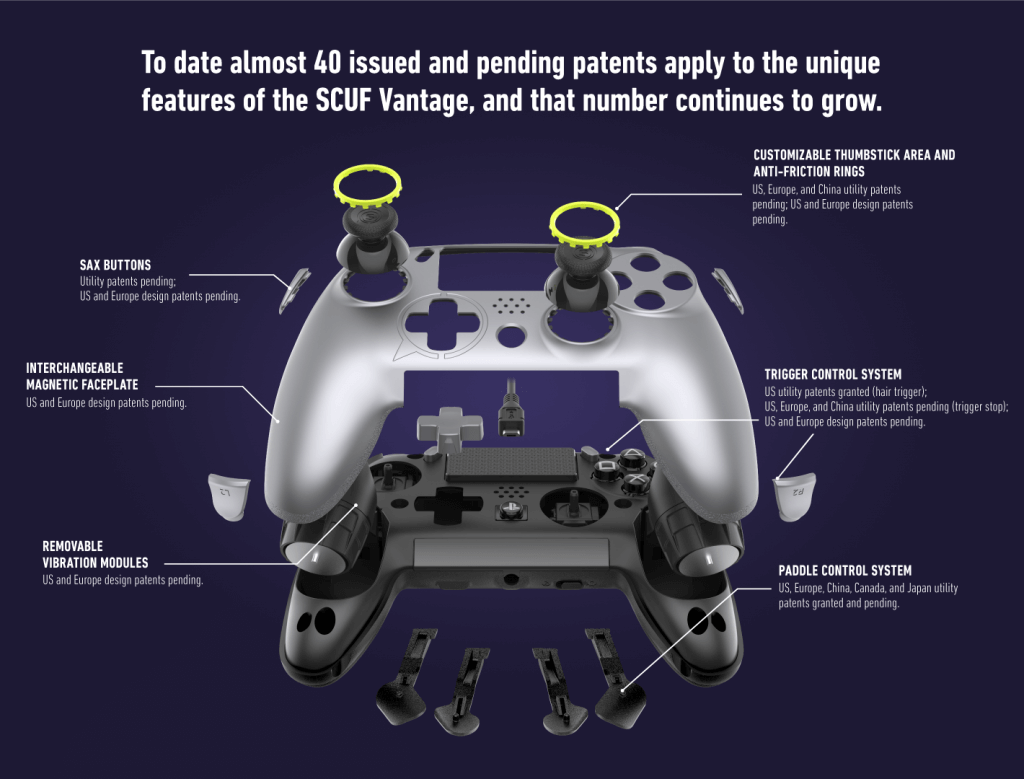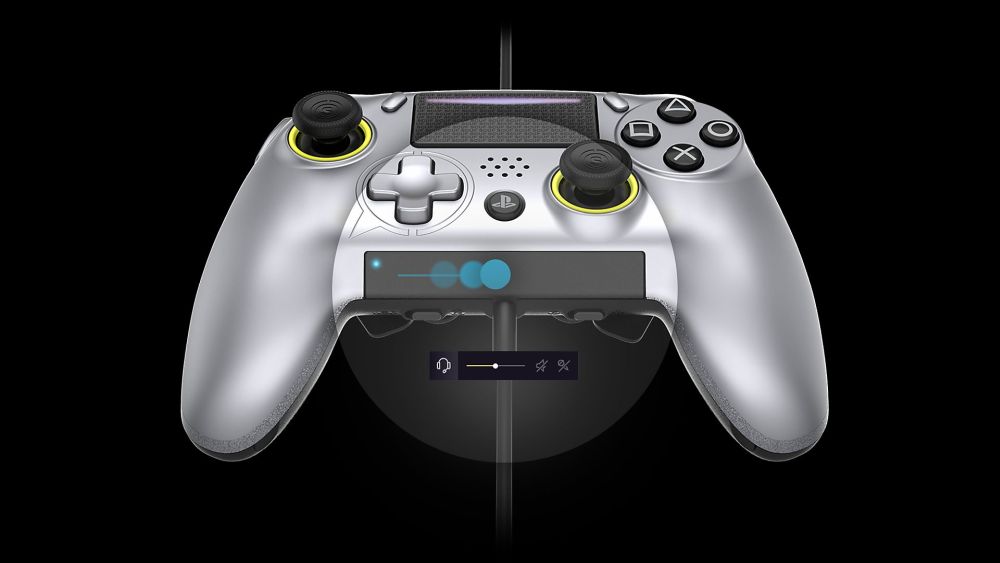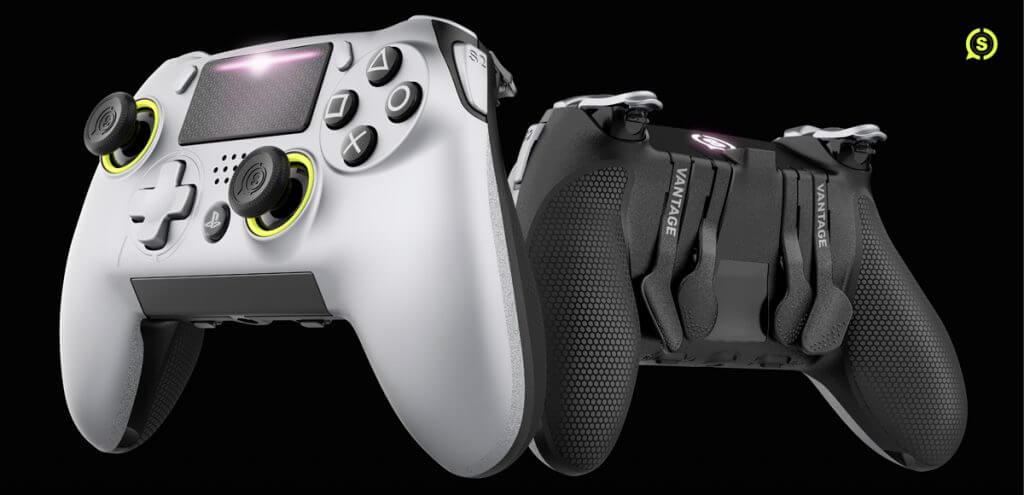What makes the SCUF Vantage controller really unique is that its joysticks, D-Pad, and Triggers have different types included. If you prefer a shorter joystick, the SCUF comes with one. If you like longer Triggers, the SCUF Vantage comes with those. They even provide concave and convex joystick tips. Hell, there’s even a flat-top D-Pad, turning it into an actual round pad. It still functions as expected, but hitting diagonals is so much easier with this customization. Fighters are wonderful with the SCUF controller because of it.

Size matters with the SCUF Vantage
One thing you must consider before buying the SCUF Vantage is how big your hands are. I bring this up simply because the controller is larger than a standard DualShock 4. To compare, my hands measure at 7.125 inches from the tip of the middle finger to the palm heel. With the average at 7.7 inches or so, I sit somewhat below that average. My thumbs do rest in the same places on both controllers, but the thumbs aren’t the only factor to consider when holding a controller.
The controller itself also weighs in a bit heavier than a DS4. The difference is slight, but it’s definitely noticeable after years of conditioning with a DS4. This added weight brings a certain anomaly for me: weight distribution. With a DS4, my pointer finger rests comfortably across the triggers and just touches the inside chassis behind the Touchpad. This means that the weight of the controller is averages out across more hand surface.
One feature I wish to mention is that the SCUF turns on the PS4 while in wireless mode. This is a big deal, conceptually, for me. After having tested the Razer Raiju, my biggest gripe with that controller was how I had to turn on my PS4 either manually or through another controller. This is micromanaging I had never had to deal with before. So, the SCUF Vantage ticks another positive checkmark here, especially in the third-party peripheral department.
Another important point to know is that the Sensor Bar on the back of the SCUF works like it does on the DS4. With other third-party controllers I’ve tried, this feature is often neglected. I personally love to type out messages using the Sensor Bar rather than hunting and pecking. I believe I’m in the minority in liking this feature, but it’s worthy of note.
The SCUF controller is about 3/8ths of an inch taller than the DS4. My pointers still rest on the Triggers, but the tips hang over the buttons rather than rest on the inside chassis. This may not seem concerning, but having less hand surface to distribute a heavier controller adds up. This especially holds true during more involved games. My time with Sekiro: Shadows Die Twice, which is already a challenging game, proved even more challenging because of how I had to hold this controller. Having less weight handled on the outside of the controller, I had to compensate with my thumbs. This meant I had to press harder on the joystick and buttons to perform how I wanted.
Indeed, practice makes perfect while adjusting to new devices. I also chose a game that demands a great deal of discipline in order to test out the SCUF Vantage. At the same time, accessibility is important. When I finally got my hands on this controller, I looked forward to cycling in the added sax paddles on the back of the controller. With them mapped to the face buttons, shooters are wonderful. Think about not having to take your right thumb off the joystick to enter a command. Instead, you have all four shape buttons mapped to sax paddles you press with your other fingers. That’s one aspect I love about the SCUF Vantage. Unfortunately, I had to adjust how I held the controller with my smaller hands. This just didn’t work too well with action games.

Fighters and shooters shine with SCUF Vantage
Fighters, on the other hand, felt great. This is, in no smart part, due to the Control Disc I installed in exchange for a standard D-Pad. Landing diagonals is so fluid, and just having to shift my thumb a bit to land those angles felt effortless. That’s the part of the SCUF controller I loved the most. If that were the standard D-Pad, I would never go back to anything else. Shooters feel great as well. Not having to lift your right thumb from the joystick just to press face buttons is such a liberating experience. It takes a bit of time to acclimate to using the sax paddles with your other fingers, but that’s just time. The reward is immense.
SCUF Gaming provided us with the wireless model. While it is wireless, it also comes with a 10-foot cord to make it a wired controller, eliminating any input lag. You even adjust between Bluetooth and wired with a switch on the bottom of the controller. Alongside that switch is another switch you use to remap buttons on the fly. These toggles made the SCUF controller feel organic and meant for the individual.
An oddity I found with this particular controller revolves around the audio port in the controller. Wireless mode does not support it. If you want to use a wired headset to chat or listen to the game, you must play in wired mode. I tend to get up and move around when I party chat with friends, so this gripe might have me as the only affected audience. What is cool, when wired, is that a touch slider adjusts volume and even toggles mute for party chat. This is quite convenient and adds to that elite feel.
At the same time, I found myself resting my thumb on the touch slider. This action mutes and unmutes your microphone. So, without realizing it, I’d mute myself. What’s weird about this is that I don’t rest my thumbs in the same way with the DS4 as I do with the SCUF. So, I’m not quite sure where that habit came from, with the only verdict I can imagine being the shape of the controller itself. The SCUF mimics the Xbox controller in many ways, from the shape and angle down to the inverted joysticks.

SCUF Vantage is great for certain cases
There is definitely an audience for the SCUF controller. Plenty of people love inverted joysticks, and I know many people who would love a controller meant for bigger hands. The level of on-the-fly customizability feels unlike anything I’ve experienced before on any front, not just gaming peripherals. Simply flipping open a magnetic front face to swap out magnetic parts feels just so damn cool. Couple that with remappable sax paddles, and you have a heavy-duty competitive controller. All of these options allow you to really figure out what your preferences are. That’s such a liberating thing.
For me, it’s just too bad this controller is the size it is. As I learned personally, the SCUF is not for everyone because of this. Even with my small hands, the Circle Pad made fighters feel so damn good, reducing effort I needed to execute the moves I wanted. Compile this with the $200 price tag, however, and there is definitely room to pause. You just have to know what your needs are when it comes to a controller. Fighters and shooters benefit the most from the SCUF Vantage. However, smaller hands quickly feel taxed by this controller. Personally, if I could rest my pointer finger on the inner chassis around the triggers, I’d be made in the shade.
Unfortunately for me, simply because of my small hands alone, the SCUF Vantage is not replacing my DS4. This is a shame for me: The SCUF Vantage feels so high-end and beneficial when it works for me.
